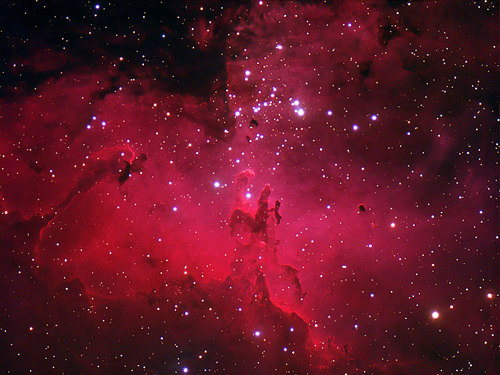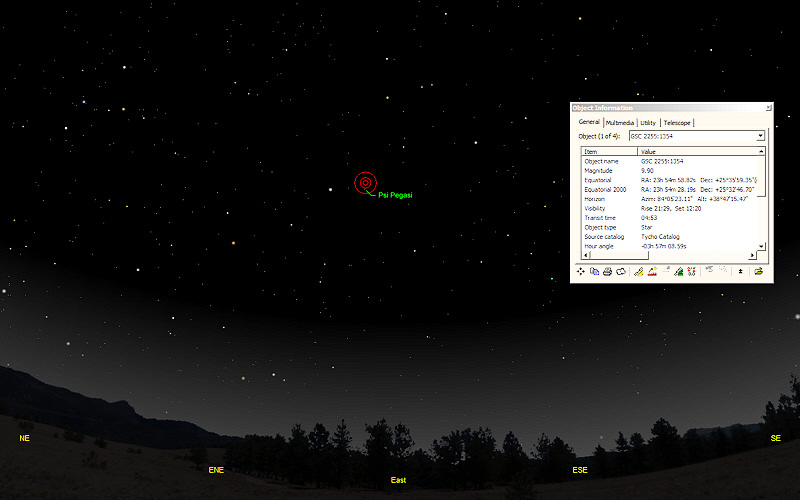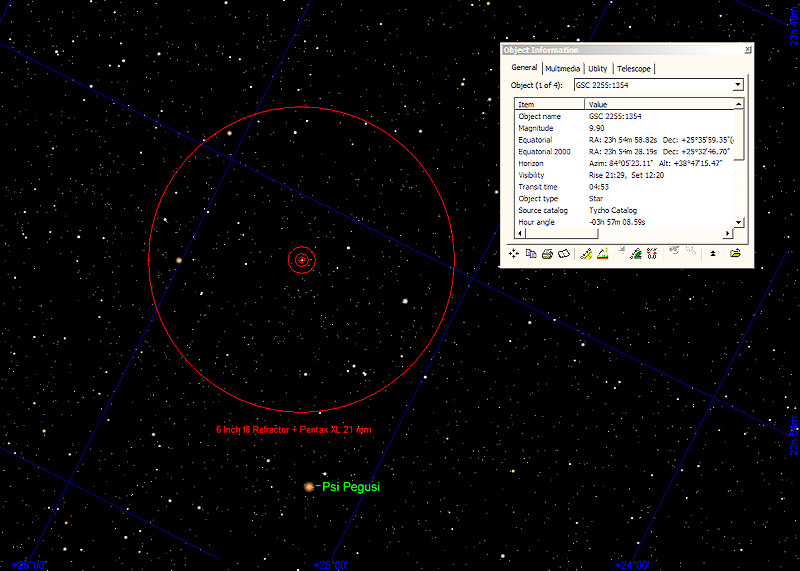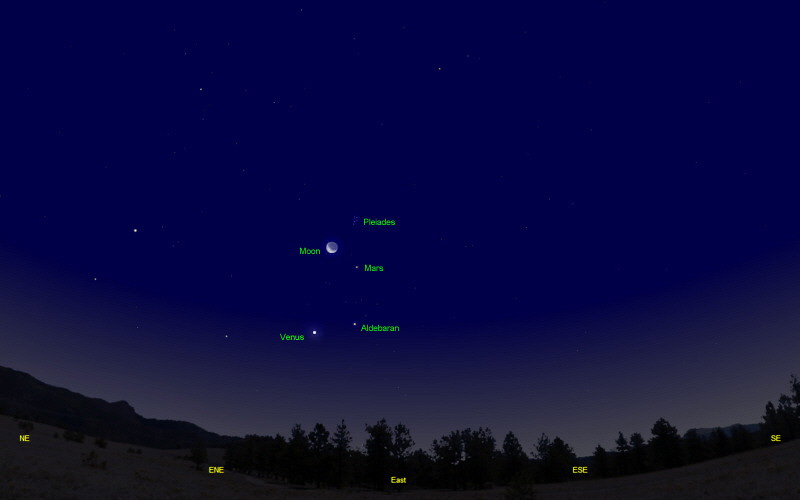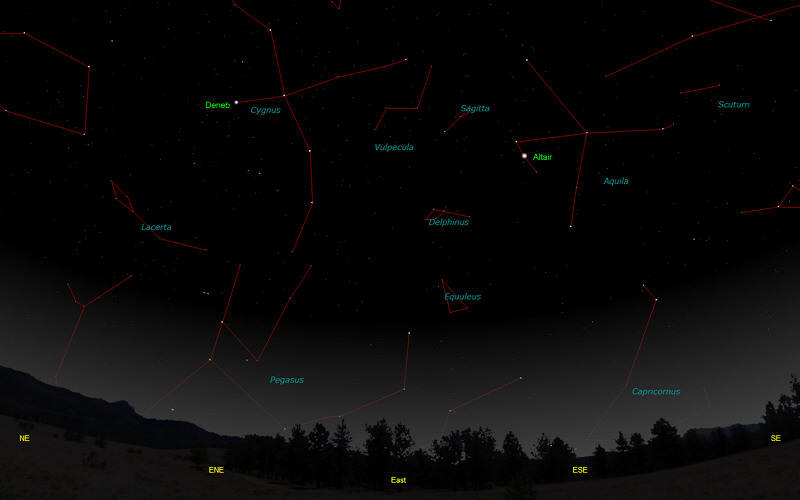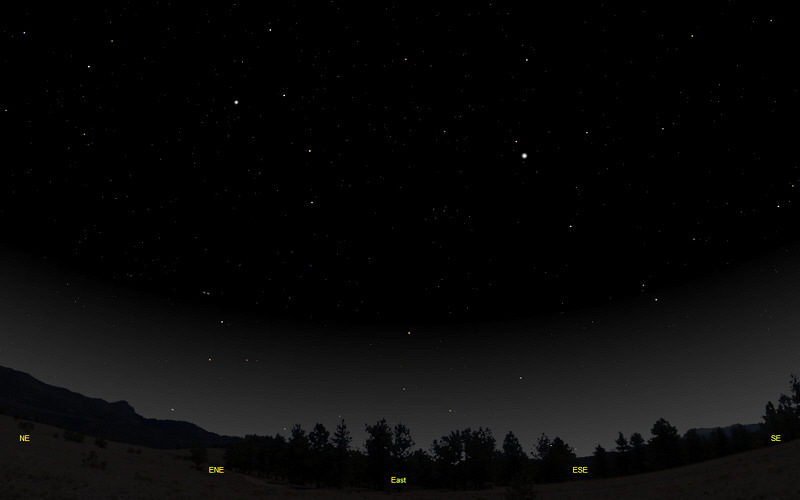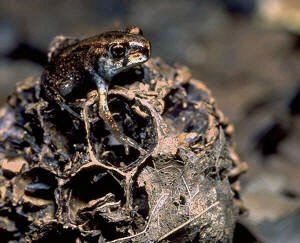The purpose of this feature is to give scout leaders, educators and naturalists an idea of some of the natural events coming up each month. We will try to cover a variety of natural events ranging from sky events to calling periods of amphibians, bird and mammal watching tips, prominent wildflowers and anything else that comes to mind. We will also note prominent constellations appearing over the eastern horizon at mid-evening each month for our area for those who would like to learn the constellations. If you have suggestions for other types of natural information you would like to see added to this calendar, let us know! Note: You can click on the hyperlinks to learn more about some of the featured items. To return to the Calendar, hit the "back" button on your browser, NOT the "back" button on the web page. All charts are available in a "printer friendly" mode, with black stars on a white background. Left clicking on each chart will take you to a printable black and white image. Please note that images on these pages are meant to be displayed at 100%. If your browser zooms into a higher magnification than that, the images may lose quality.
Notes and Images From May and June 2009 We took this image of Messier 16, the Eagle Nebula, on May 30th. The night was cool and pleasant, and along with our normal spring chorus of Northern Cricket Frogs, Green Frogs and Cope's Gray Treefrogs, we had a very vocal Yellow-breasted Chat that sang through the evening and into the early morning hours. The Eagle Nebula is an emission nebula and an area of active star formation. The cluster of stars above the center of the image emit copious amounts of high-energy radiation, which in turn causes the surrounding hydrogen gas to fluoresce in the characteristic wavelength of hydrogen-alpha light. This is a natural-color shot and represents what you might see with your eyes if they much more sensitive to faint light. Clicking on the image will take you to a high resolution view, more about the nebula, and links to a couple of amazing images by the Hubble Space Telescope. The Eagle Nebula is about 7,000 light-years away, and is approximately 70 light-years by 55 light-years in size.
We found this Venusta Orchard Spider on June 13th. The web was constructed at an angle of about 50 degrees from vertical, and the spider hung beneath the web. The scientific name of this spider is Leucauge venusta. The species name venusta is from the Latin for beautiful, and these spiders are marked in stunning colors on the underside of their abdomen. Orchard spiders are members of the family Tetragnathidae, the large-jawed orb weavers. They are small and jewel-like. Male body length is only about 1/8 inch, while females measure from 1/4 inch to 3/8 inch long. They range throughout the United States and southern Canada. Typical habitats include shrubby meadows and woodland edges. We found this one in our flower bed. They are harmless and quite beneficial, feeding on many small insects.
Sky Events for July 2009: A dark spot appeared on Jupiter sometime between July 17th and July 19th. The dark area is believed to be caused by either the collision of an asteroid or a comet with the giant planet. For more on the spot and where it is located on the planet, go to www.skyandtelescope.com. Standing in the Shadow of an Asteroid: On July 15th, a Sky and Telescope AstroAlert was issued that announced an upcoming sky event in Pegasus. In the early morning hours of Sunday, July 19th, the asteroid 790 Pretoria, a chunk of rock approximately 100 miles in diameter, will occult (pass in front of) a 10th magnitude star in Pegasus, causing it to dim for about 16 seconds. The narrow path of the asteroid's shadow races across the country from south to north at a speed of over 400 miles per hour! Nashville is in the shadow path, and the event should take place shortly after 1:00am CDT early Sunday morning. More on the occultation can be found here, including live on-line viewing and a great interactive map of the shadow path. If you plan to visually observe the occultation, keep in mind that you will need a four inch aperture telescope or larger, as the star that is being occulted, while not particularly hard to find, is not a naked eye star. If you click on either of the charts below, you will be taken to a black-stars-on-white-background finder chart that you can print out to use at the telescope. The first chart below shows the sky looking east at 1:00am in the early morning hours of Sunday, July 19th. Use your finder scope to locate 4th magnitude Psi Pegasi, then use the detailed finder chart to locate the 10th magnitude star GSC 2255:1354, which is the star being occulted by the asteroid. Start observing at 1:00am, but give yourself plenty of time before that to locate the the star field. To calculate the field of view of your eyepiece compared to the field of view shown in the detailed chart below, find what magnification that you are using (divide the telescope's focal length by the focal length of the eyepiece). Then divide the apparent field of the eyepiece (if you don't know it, assume 50 degrees) by the magnification. For instance, if your eyepiece's apparent field of view is 50 degrees and your magnification is 50 power, your field of view would be one degree. The Earth is at aphelion, its farthest point from the sun for the year, about 9:00pm CDT on July 3rd. Evening Sky: Saturn is about 26 degrees above the western horizon at dusk as the month begins. The rings are tilted only 3.2 degrees to our line of sight. Saturn will sink lower into the twilight glow as the month progresses. Jupiter rises a little before 11:00pm at the beginning of the month but you will need to wait till the early morning hours to get a good telescopic look. Jupiter and Neptune pass fairly close to each other during the first two weeks of the month. On July 11th, Jupiter is only about 1/2 degree from Neptune, and the 5th magnitude star Mu Capricorni is midway between the two planets. Morning Sky: Venus rises around 2:50am at the beginning of the month. If you're tired of the summer heat, early morning is a good time to be outdoors in July. The air is pleasantly cool, the views of the dawn sky are beautiful, and you also get to hear the morning bird chorus at its peak. On the morning of July 18th, the waning crescent Moon forms a pretty grouping with Venus, Mars, Aldebaran, and the Pleiades. The image below shows the view at 4:30am on the morning of July 18th. As always, a pair of binoculars will be helpful. All times noted in the Sky Events are for Franklin, Tennessee and are Central Daylight Time. These times should be pretty close anywhere in the mid-state area. Constellations: The view below shows the sky looking east at 10:00pm CDT on July 15th. The first view shows the sky with the constellation outlined and names depicted. Star and planet names are in green. Constellation names are in blue. The second view shows the same scene without labels. Prominent constellations this month in the eastern sky are Cygnus, the Swan, with its bright star Deneb, and Aquila, the Eagle, with its bright star Altair. Below and to the left of Altair is the constellation of Delphinus, the Dolphin, looking like it's leaping over the eastern horizon. Above Delphinus look for the arrow-like form of Sagitta, the Arrow. Between Sagitta and Cygnus lie the faint stars of Vulpecula, the Fox.
On Learning the Constellations: We advise learning a few constellations each month, and then following them through the seasons. Once you associate a particular constellation coming over the eastern horizon at a certain time of year, you may start thinking about it like an old friend, looking forward to its arrival each season. The stars in the evening scene above, for instance, will always be in the same place relative to the horizon at the same time and date each July. Of course, the planets do move slowly through the constellations, but with practice you will learn to identify them from their appearance. In particular, learn the brightest stars (like Deneb and Altair in the above scene), for they will guide you to the fainter stars. Once you can locate the more prominent constellations, you can "branch out" to other constellations around them. It may take you a little while to get a sense of scale, to translate what you see on the computer screen or what you see on the page of a book to what you see in the sky. Look for patterns, like the stars that make up the constellation Cygnus. The earth's rotation causes the constellations to appear to move across the sky just as the sun and the moon appear to do. If you go outside earlier than the time shown on the charts, the constellations will be lower to the eastern horizon. If you observe later, they will have climbed higher. As each season progresses, the earth's motion around the sun causes the constellations to appear a little farther towards the west each night for any given time of night. If you want to see where the constellations in the above figures will be on August 15th at 10:00pm CDT, you can stay up till 12:00pm CDT on July 15th and get a preview. The westward motion of the constellations is equivalent to two hours per month. Sky Publishing has just come out with a beautiful and compact star atlas, Sky & Telescope's Pocket Star Atlas. It is destined to become a classic, and is a joy to use at the telescope. A good book to learn the constellations is Patterns in the Sky, by Hewitt-White. You may also want to check out at H. A. Rey's classic, The Stars, A New Way to See Them. For skywatching tips, an inexpensive good guide is Secrets of Stargazing, by Becky Ramotowski. A good general reference book on astronomy is the Peterson
Field Guide,
A Field Guide to the Stars and Planets, by Pasachoff.
The book retails for around $14.00. Starry Night has several software programs for learning the night sky. Visit the Starry Night web site at www.starrynight.com for details.
Amphibians:
July’s frogs and toads are much like June’s. Listen for Cope's Gray Treefrogs, Gray Treefrogs, Bird-Voiced Treefrogs, Green Treefrogs and Barking Treefrogs. Northern Cricket Frogs and Southern Cricket Frogs call a lot during July, and the calls of Bullfrogs and Green Frogs fill the night air. After heavy rains listen for the high, insect-like call of the Eastern Narrowmouth Toad and the strange-sounding Eastern Spadefoot. Be sure to look closely at young toads you encounter. Sometimes we find young Eastern Spadefoots foraging during the day. A young Eastern Spadefoot will have vertical pupils, a tiny spade on its rear feet and will often have some red warts, even when only a fraction of an inch long. A hand lens helps to see these features (or turn your binoculars around and use them for a magnifying glass.)
Archives (Remember to use the back button on your browser, NOT the back button on the web page!) Natural Calendar February 2009 Natural Calendar December 2008 Natural Calendar November 2008 Natural Calendar September 2008 Natural Calendar February 2008 Natural Calendar December 2007 Natural Calendar November 2007 Natural Calendar September 2007 Natural Calendar February 2007 Natural Calendar December 2006 Natural Calendar November 2006 Natural Calendar September 2006 Natural Calendar February 2006
Natural Calendar
December 2005
Natural Calendar
November 2005
Natural Calendar
September 2005
Natural Calendar
February 2005
Natural Calendar
December 2004
Natural Calendar
November 2004
Natural Calendar
September 2004
Natural Calendar
February 2004
Natural Calendar
December 2003
Natural Calendar
November 2003
Natural Calendar
September 2003 Natural Calendar February 2003 Natural Calendar December 2002 Natural Calendar November 2002 Nature Notes Archives: Nature Notes was a page we published in 2001 and 2002 containing our observations about everything from the northern lights display of November 2001 to frog and salamander egg masses. Night scenes prepared with The Sky Professional from Software Bisque All images and recordings © 2009 Leaps |
|||||
